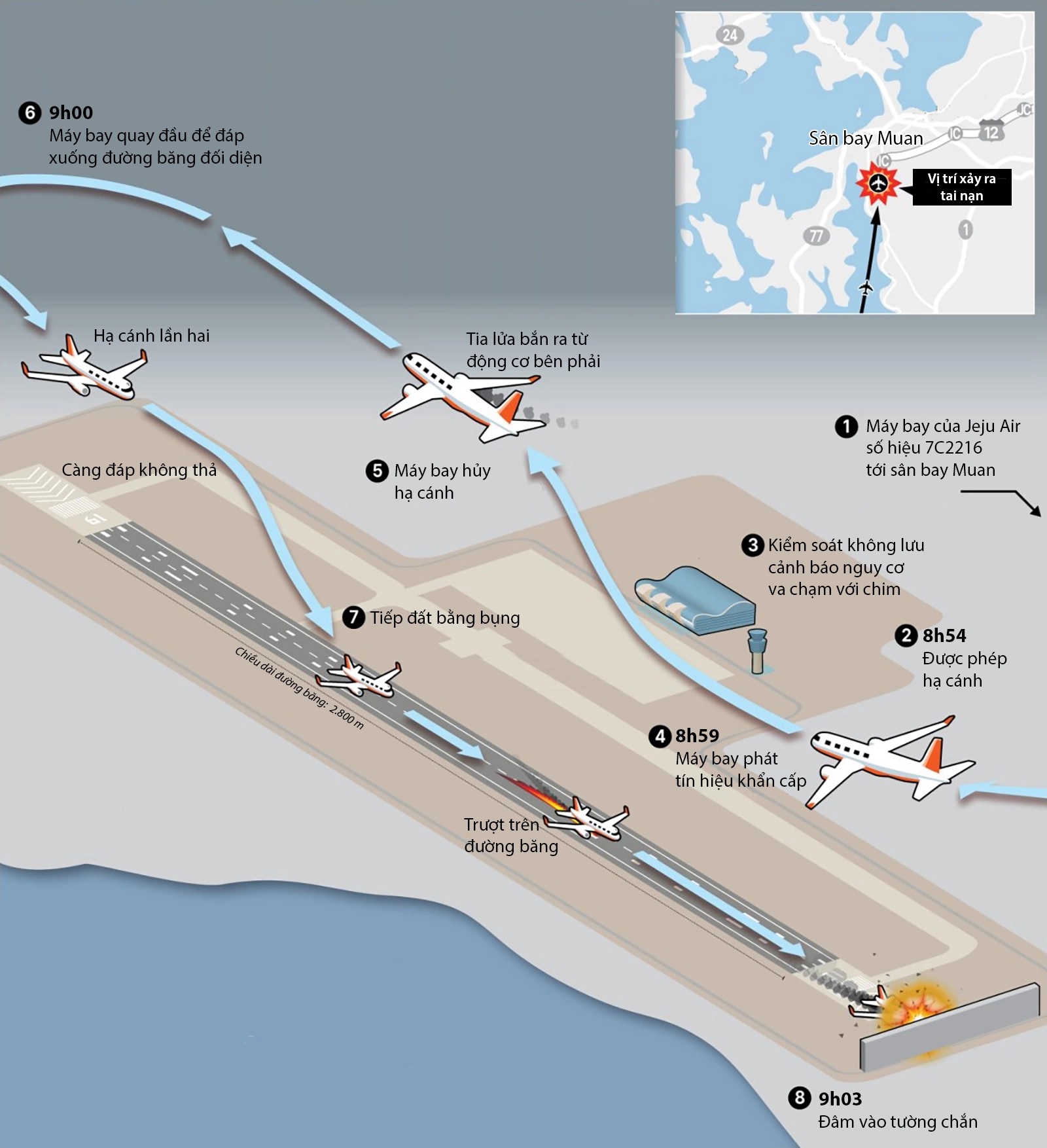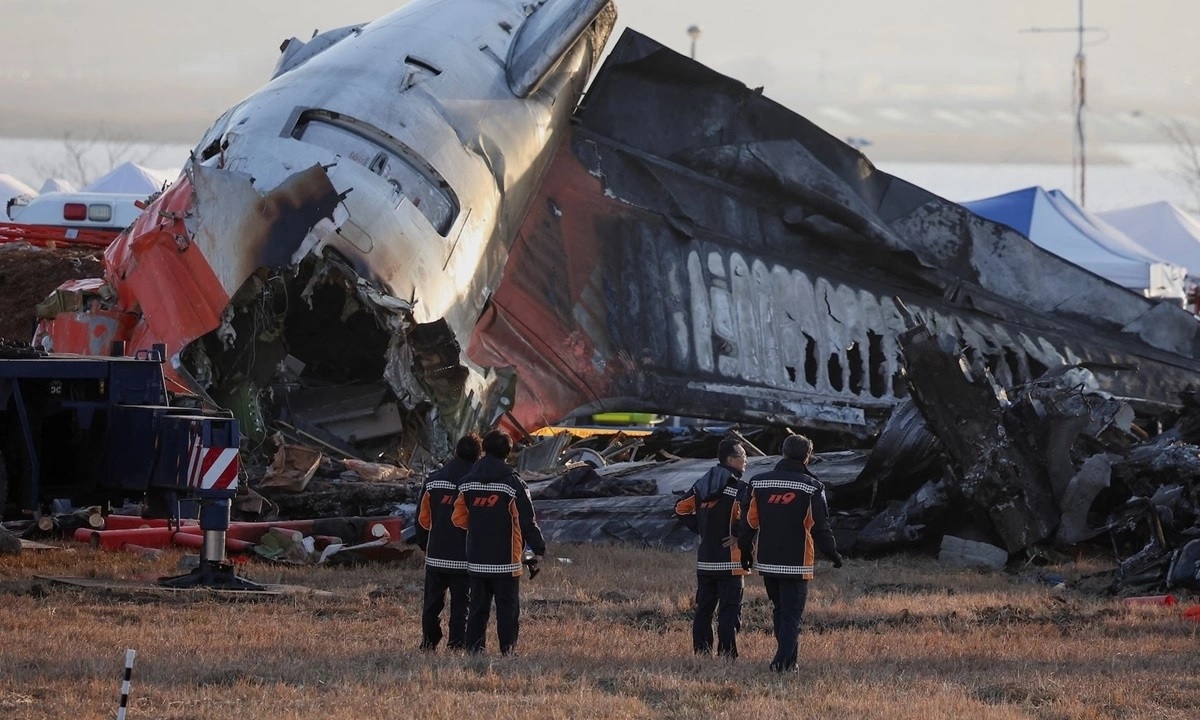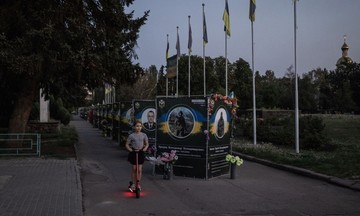Minutes before Jeju Air flight 2216 attempted to land at Muan International Airport in South Jeolla Province on 29/12/2024, the pilot mistakenly shut down the functioning left engine instead of the right engine, which had been severely damaged by a bird strike.
This is the preliminary conclusion reached by South Korea's Aviation and Railway Accident Investigation Board (ARAIB) last week.
Shutting down the wrong engine resulted in a complete loss of thrust and power from both engines during the landing attempt. The plane attempted a gear-up landing, skidding on its belly before crashing into a concrete wall and catching fire.
Two flight attendants survived, but 179 passengers and crew members perished.
 |
The flight path of the Jeju Air plane before the disaster. Graphics: Yonhap |
The Jeju Air pilots' union criticized the ARAIB report, "firmly rejecting the malicious attempt to blame the pilots." Experts also caution against prematurely concluding pilot error, citing various objective reasons that could have led to the mistake during the emergency.
Joe Jacobsen, an aviation safety expert who has worked for Boeing and the Federal Aviation Administration (FAA), suggests the pilot might have misidentified the engine due to the split-second decision-making required and the potential impact of the power loss on the aircraft's electronic systems.
Investigators reported that both engines vibrated after the bird strike, indicating damage. Bird feathers were found in both engines. The right engine exhibited signs of a damaged compressor, causing it to emit flames and smoke, according to investigators. However, this engine still had power immediately before the crash landing.
An aircraft's main engines provide thrust and power the aircraft through onboard generators. US aviation experts suggest the burning right engine might have still produced some thrust, but not enough to save the plane.
In a Boeing cockpit, critical engine parameters and warnings are managed by the Engine Indicating and Crew Alerting System (EICAS). This system uses two screens to display engine warnings based on severity, accompanied by warning lights, audio alerts, and text messages.
 |
Firefighters stand before the wreckage of the Jeju Air plane after it skidded off the runway at Muan International Airport, South Korea, on 31/12/2024. Photo: Reuters |
John Goglia, a former member of the US National Transportation Safety Board, states that pilots can typically quickly identify a malfunctioning engine under normal circumstances. However, when systems fail or data becomes unreliable, serious issues can arise. "If the screens went blank during the incident, they wouldn't have much data to assess the situation," he said.
In flight simulators, pilots are trained for such scenarios using pre-determined scripts, sometimes based on real incidents, according to Goglia. But even such training doesn't guarantee successful handling of every unexpected situation, especially when crucial functions and information are lost.
Jacobsen also believes that if the display signals were lost after the bird strike, the Jeju Air pilot might not have known which engine was failing and needed fuel shut off. In this scenario, shutting down the wrong engine, cutting off all power and thrust, would be a likely mistake.
Engine power loss eliminates thrust and the ability to generate electricity for the aircraft, according to aviation experts. In such cases, pilots must rely on manual controls and emergency procedures for landing.
Previous aviation accidents, including the 1989 Kegworth Air disaster and the 2015 TransAsia Airways crash, demonstrate the catastrophic consequences of misidentifying a failed engine. In both cases, pilots shut down the functioning engine, leading to insufficient power for continued flight and resulting in dozens of fatalities.
Investigators of the Jeju Air tragedy have not yet released information about the cockpit displays' status after the bird strike. They aim to complete the investigation by June of next year.
However, the flight data recorder stopped recording five seconds after the left engine was shut down. This creates an information gap regarding the final minutes of the flight, during which the pilot attempted an emergency landing.
Many questions remain unanswered, including why the landing gear was not deployed manually after the engine power loss, and whether the aircraft's auxiliary power unit was functioning. "What if both engines were damaged and the two pilots had no way of knowing?" Jacobsen asks. "That would change everything."
Thuy Lam (According to Reuters, KBS, Gulf News)












